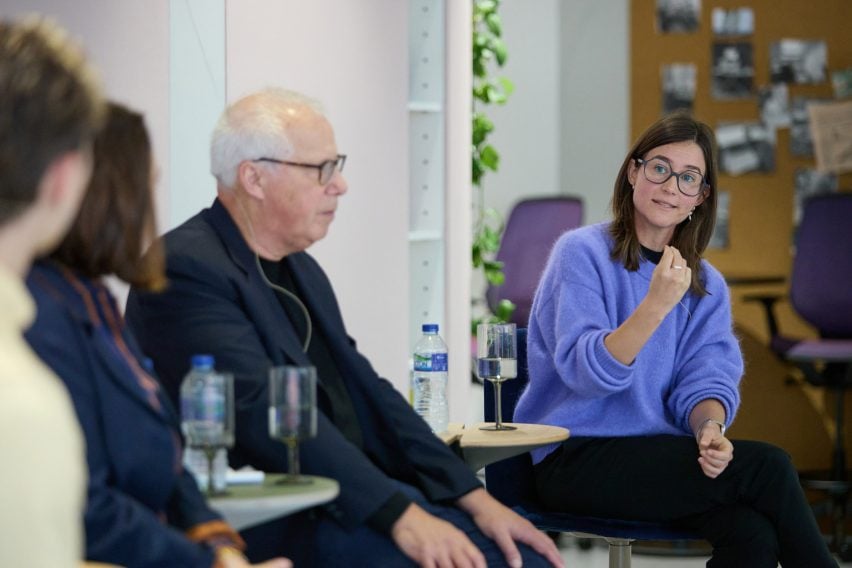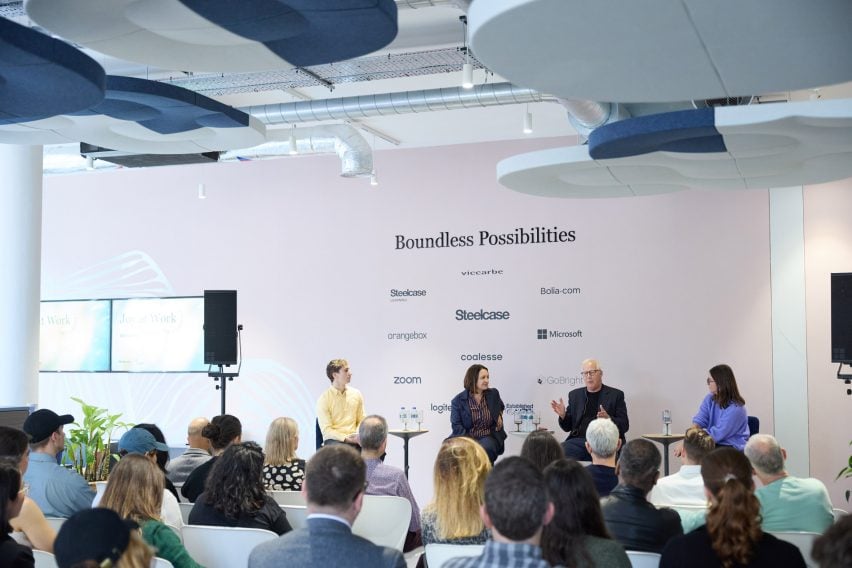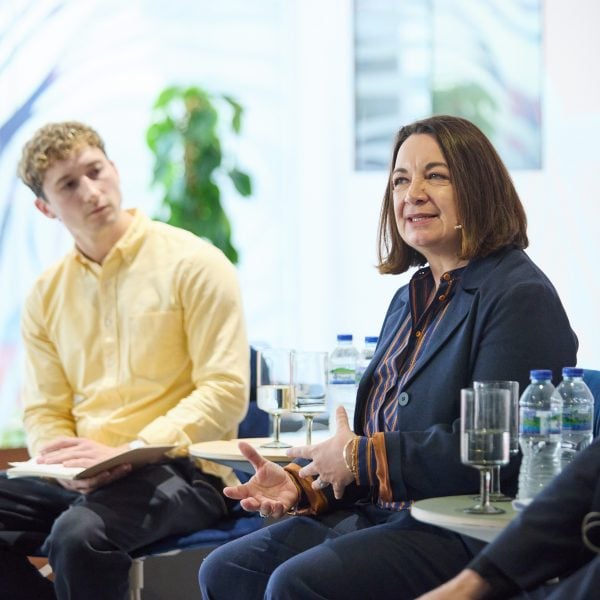Promotion: employees are returning to the workplace and office design is ready to cater to their wants like by no means earlier than, based on audio system at a panel dialogue hosted by Dezeen and furnishings model Steelcase.
The panel, titled Pleasure at Work, happened at Steelcase‘s London showroom and featured the corporate’s EMEA director for office design and consulting Elena de Kan, architect and Foster + Companions accomplice Simona Bencini, and workplace design skilled and WorkTech Academy chair Jeremy Myerson, with Dezeen options editor Nat Barker moderating.
The audio system addressed themes of elated work environments, wellness and whether or not there was a elementary shift within the relationship between folks and their workplaces.
Referencing the as soon as in style method of filling workplaces with slides and ping-pong tables, as exemplified by tech companies within the 2010s, the panellists pressured that traits in workplace design have moved on.
“In case you take a look at the world of environmental psychology, there’s lots of people doing lots of analysis on the market and there is a very constant sample,” stated Myerson. “What makes folks snug and happy at work? The primary standards is having a way of management.”
“This manifests itself in quite a lot of methods, however having autonomy and selection and management, that’s the primary factor.”
Reflecting on his 2016 Dezeen interview through which he lambasted Google’s workplace design, Myerson stated the issue with the “playground method” was that individuals have been being compelled to suit right into a office panorama moderately than being able to decide on the setting that labored for them.

“I additionally felt that there was one thing fake, one thing not proper, about pretending that work is enjoyable, that it is a playground,” stated Myerson. “It isn’t. Work is figure.”
“Individuals need to get a way of goal, they need to belong, they need to really feel they’re doing a great job. And that is why I used to be in opposition to the equipment of play and enjoyable. I believe we have to take a look at enjoyable at a extra profound stage.”
De Kan, who stated the subject of how area shapes behaviour has been her ardour since college, agreed that pleasure within the context of labor appeared completely different to pleasure exterior of it.
“We take pleasure in that second the place our brains begin firing,” stated De Kan. “That is the place pleasure and work is inseparable. And that is what we need to help within the locations that we come to.”

She additionally identified that “poisonous positivity” might negate the nice intentions of overly exuberant office design.
“There is a hazard with that if we focus an excessive amount of on the enjoyable component,” she stated. “To say that we’ve to have enjoyable always, at each second, and it is the driving component, no – the driving component is to do one thing properly collectively.”
The entire panellists agreed that wellbeing was foundational to what may very well be considered “pleasure” within the office, with interplay being one other necessity.
Bencini referenced Foster + Companions’ Stirling Prize-winning Bloomberg constructing, for which they labored alongside Steelcase. The constructing is seen as extremely influential within the workplace design discipline and consists of an infinite spiral staircase unfurling by means of its centre.

“In fact we had the conventional cores with the steps, however Michael Bloomberg stated, ‘you possibly can’t stumble upon folks within the staircase, it is too tight’,” Bencini stated. “Within the raise, folks need to simply enter the raise and exit… We have to create one thing the place folks stumble upon one another and slowly stroll up the staircase and hold speaking and exchanging concepts.”
“The central staircase turned a degree of contact between folks, between departments,” she continued. “The entire workplace was designed to be a spot the place folks work together and create recent concepts.”
Total, Myerson stated, actual engagement with concepts round inclusivity and neighborhood is bringing about extra constructive workplace designs than ever, and the office itself was proving resilient to the pandemic-triggered work-from-home increase.
“In case you’re within the workplace design or improvement sector, there’s motive for optimism. 2024 has seen a gentle swing when it comes to return to the workplace,” stated Myerson. “The newest figures from McKinsey [show] globally we’re in 3.5 days every week, which isn’t far off pre-pandemic ranges.”

“I believe the disruption between workplace and house is that individuals need to return to the workplace, however they do not need to return to the identical pre-pandemic workplace,” he continued. “Corporations are introducing lots of facilities and critically, they’re additionally altering the connection with the neighbourhood, the district and town.”
“It is extra porous, it is extra permeable, there’s way more alliances with eating places and facilities.”
He gave the instance of Reserving.com workplaces in Amsterdam, which embody a employees restaurant run by a refugee charity giving jobs to refugees.
“What they’re making an attempt to say is the workplace has obtained to have some neighborhood goal, it is obtained to have some social worth,” stated Myerson. “I am vastly bullish for the workplace sector, and I wasn’t a few years in the past.”
“The pandemic has unlocked a number of the entrenched attitudes and now we’re getting some actual design creativity and social enterprise round it.”
The Pleasure at Work panel happened on the Steelcase WorkLife Heart in London on Thursday, 17 October.
For extra data on Steelcase, see the corporate’s web site.
Partnership content material






